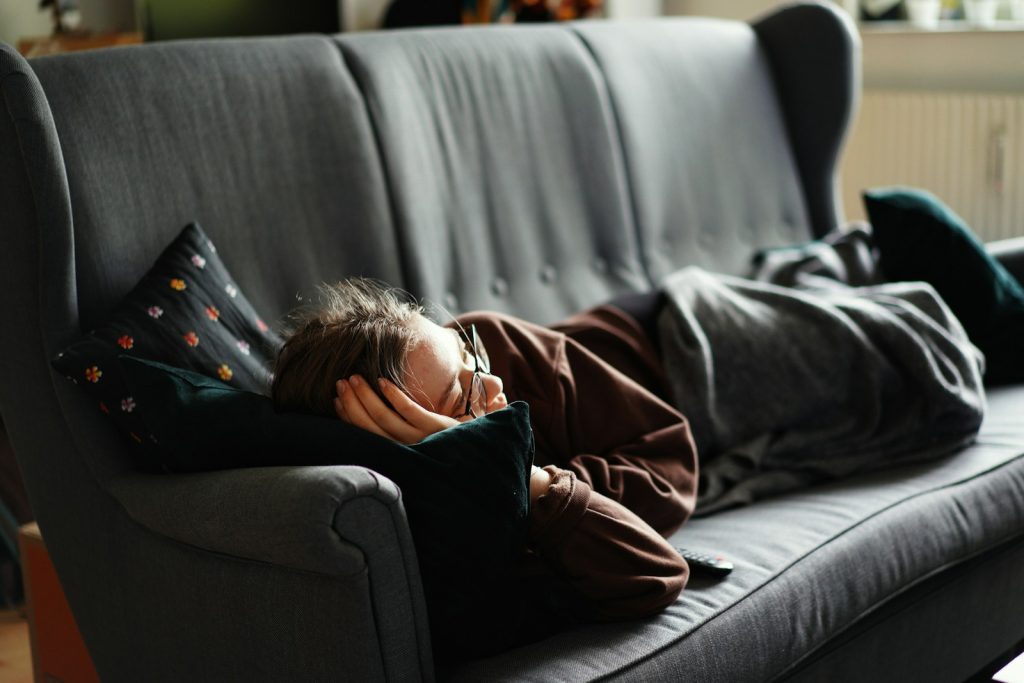The remarkable power of sleep for recovery and healing
By understanding the positives, individuals can better support their mental health and injury management by utilising sleep for recovery and healing
The Physiological Impact of sleep for recovery and healing
Tissue Repair and Regeneration
During deep sleep stages, particularly slow-wave sleep (SWS), the body increases the production of growth hormones. These hormones are essential for tissue growth and repair, accelerating cellular repair processes and enhancing the synthesis of proteins needed for healing ligaments, tendons, and muscles.

Inflammation Reduction
Chronic inflammation is a common challenge in injury recovery. Sleep helps modulate the immune system and reduce inflammatory markers in the body. Adequate rest decreases the production of pro-inflammatory cytokines, substances that can delay healing and exacerbate pain. This anti-inflammatory effect is crucial for managing pain and speeding up rehabilitation through sleep for recovery and healing.
Pain Perception
Poor sleep is linked to increased pain sensitivity. Conversely, good quality sleep can enhance pain tolerance. During sleep, the brain processes and dampens pain signals, helping patients experience less pain during waking hours, making physical therapy exercises more tolerable and effective. Sleep deprivation lowers the pain threshold, making patients more susceptible to discomfort and chronic pain.
The Science of sleep for recovery and healing
The Body’s Repair Processes During Sleep
During sleep, the body undertakes several critical repair and maintenance functions, essential for individuals recovering from injuries:
Protein Synthesis:
Sleep increases the rate of protein synthesis, helping repair muscles, tendons, ligaments, and other tissues.
hormone release:
Growth hormones released during deep sleep stages play a crucial role in cell reproduction and regeneration.
immune function enhancement:
Sleep boosts the immune system by promoting the production of cytokines, aiding in fighting infections and reducing inflammation.

The Role of Deep Sleep (NREM) in Tissue Repair and Growth
Deep sleep, or slow-wave sleep (SWS), is a critical phase characterised by slower brain waves and is a particularly restorative in sleep for recovery and healing:

growth hormone Release:
Stimulates cell growth and reproduction, vital for repairing tissues damaged by injury.
increased blood-flow to muscles:
Supplies muscles with oxygen and nutrients necessary during sleep for recovery and healing
reduced cortisol levels:
Lowers stress hormone levels, reducing inflammation and promoting tissue repair.
cellular repair:
Allows energy to be directed towards physical healing, with the body’s cells repairing themselves most effectively during deep sleep.
Sleep’s Role in Reducing Inflammation
Sleep plays a critical role in regulating the body’s inflammatory responses:
Reduction of Pro-Inflammatory Cytokines:
Adequate sleep decreases the production of pro-inflammatory cytokines like interleukin-6 (IL-6) and tumour necrosis factor-alpha (TNF-alpha), which promote inflammation.
Regulation of the HPA Axis:
Proper sleep helps regulate the hypothalamic-pituitary-adrenal (HPA) axis, leading to lower cortisol levels and reduced inflammation.
enhanced immune function:
Sleep boosts the activity of anti-inflammatory agents like interleukin-10 (IL-10), promoting a balanced immune response.

Connection Between Reduced Inflammation and Faster Injury Recovery
Reducing inflammation is a crucial aspect of sleep for recovery and healing
decreased pain and swelling:
Reduces pain and swelling, enhancing mobility and the ability to perform rehabilitation exercises.
acccelerated tissue repair:
Reduces the collateral damage to surrounding tissues, making the healing process more efficient.
Improved Muscle Recovery:
Promotes better muscle regeneration and strength rebuilding.
Example of a Patient Who Improved Recovery Timeline with Better Sleep
John, a professional football player, struggled with rehabilitation after a severe hamstring injury. His physiotherapist/sports rehabilitator recommended focusing on sleep improvement. Implementing a consistent sleep routine, creating a restful sleep environment, and incorporating relaxation techniques before bed led to a significant reduction in pain and inflammation. John’s recovery timeline improved dramatically, allowing him to return to the field faster than anticipated.
Cognitive and Emotional Benefits oF sleep for recovery and healing

Mental Health and Motivation:
Recovering from an injury can be mentally and emotionally taxing. Sleep is fundamental for mental health, affecting mood, stress levels, and overall psychological resilience. Good sleep helps reduce symptoms of anxiety and depression, which are common in individuals dealing with chronic pain or prolonged rehabilitation. This mental well-being translates to greater motivation and adherence to physiotherapy protocols.
Cognitive Function and Learning:
Sleep is essential for cognitive functions such as memory consolidation, learning, and decision-making. For physiotherapy patients, this means better retention of therapeutic exercises and techniques taught during sessions. Improved cognitive function ensures that patients can accurately follow their rehabilitation routines, reducing the risk of re-injury.
Practical Tips for Enhancing Sleep for Rehabilitation
Establish a Sleep Routine:
Encouraging patients to go to bed and wake up at the same time every day helps regulate sleep cycles. Consistency in sleep schedules reinforces the body’s internal clock, promoting better sleep quality.
create a restful environment:
A conducive sleep environment includes a comfortable mattress and pillows, a cool and dark room, and minimal noise and electronic distractions. Calming scents like lavender and a clutter-free space can also enhance sleep quality.
Mindful Nutrition and Hydration:
What and when patients eat can significantly affect their sleep. A balanced diet rich in sleep-promoting nutrients such as magnesium and tryptophan, avoiding heavy meals and caffeine close to bedtime, and staying hydrated without over drinking before sleep are practical steps to improve sleep..
Incorporate Relaxation Techniques:
Techniques such as progressive muscle relaxation, deep breathing exercises, and mindfulness meditation can help reduce stress and prepare the body for sleep. These practices can be particularly beneficial for patients dealing with pain and anxiety.
Naps and injury Management
The positives of naps in injury management:
enhanced recovery:
Napping can contribute to overall rest and recovery, giving the body additional time to repair tissues, reduce inflammation, and manage pain.
pain relief:
Short naps can help manage pain by providing a temporary respite, allowing the body to relax and reduce the sensation of discomfort.
Energy boost:
Napping can provide an energy boost, making it easier for patients to engage in physical therapy exercises and other rehabilitation activities.

The negatives of naps in injury management:
inconsistent recovery:
Irregular nap patterns can lead to inconsistent recovery periods, which might interfere with the body’s natural healing processes.
reduced night-time sleep:
Excessive napping during the day can reduce the need for sleep at night, potentially disrupting the deep sleep stages critical for tissue repair and growth.
potential of over-resting:
Over-relying on naps instead of engaging in active rehabilitation exercises can hinder progress in physical therapy, as movement and activity are crucial for effective injury recovery.
Balancing Naps for Optimal Benefits
By understanding and balancing the positives and negatives of napping, individuals can better support their mental health and injury management, enhancing overall recovery and well-being;

limit duration:
Keep naps short (20-30 minutes) to avoid deep sleep stages that can cause grogginess and nighttime sleep disruption.
consistency:
Nap at the same time each day to regulate the body’s internal clock and minimise disruption to nighttime sleep.
purposeful napping:
Use naps strategically to manage fatigue and boost energy levels, ensuring they complement, rather than replace, a good night’s sleep.
monitor effects:
Keep track of how naps affect both mental health and injury recovery, adjusting habits as needed to find the most beneficial routine.
Creating a Sleep-Conducive Environment
Tips for Creating an Environment That Promotes Restful Sleep
- Comfortable Bedding: Invest in a quality mattress and pillows.
- Cool and Dark Room: Maintain a cool, dark environment.
- Minimise Noise: Use earplugs or white noise machines.
- Limit Screen Time: Reduce screen exposure before bed.
- Declutter: Keep the bedroom tidy.
- Use Calming Scents: Aromatherapy with essential oils.
- Comfortable Sleepwear: Wear loose, breathable clothing.
- Consistent Sleep Schedule: Regulate your body’s internal clock.
Importance of Routine, Sleep Hygiene Practices, and Managing Stress
- Routine: Establish a consistent pre-sleep routine.
- Sleep Hygiene Practices: Regular exercise, balanced diet, and proper hydration.
- Managing Stress: Incorporate mindfulness, meditation, deep breathing, and journaling
Advice from Physiotherapists on sleep for recovery and healing
- Personalised Recommendations: Tailor sleep hygiene practices to individual needs.
- Gradual Implementation: Introduce changes gradually.
- Consistency: Emphasise daily adherence to new habits.
- Tracking Progress: Use a sleep diary to monitor patterns and adjust strategies.
- Education and Resources: Provide educational materials and recommend helpful apps, books, or websites.
If you wish to seek further help or speak to a practitioner about any of the above, call us on 0800 731 2738 or book online here.
You can also view all the services we provide within our clinics on our website, as well as checking out our other blogs and content.
For more free tips and information, make sure to follow our Facebook and Instagram pages. We also post client stories, so you can see how we’ve helped people get back to doing the things they enjoy!



